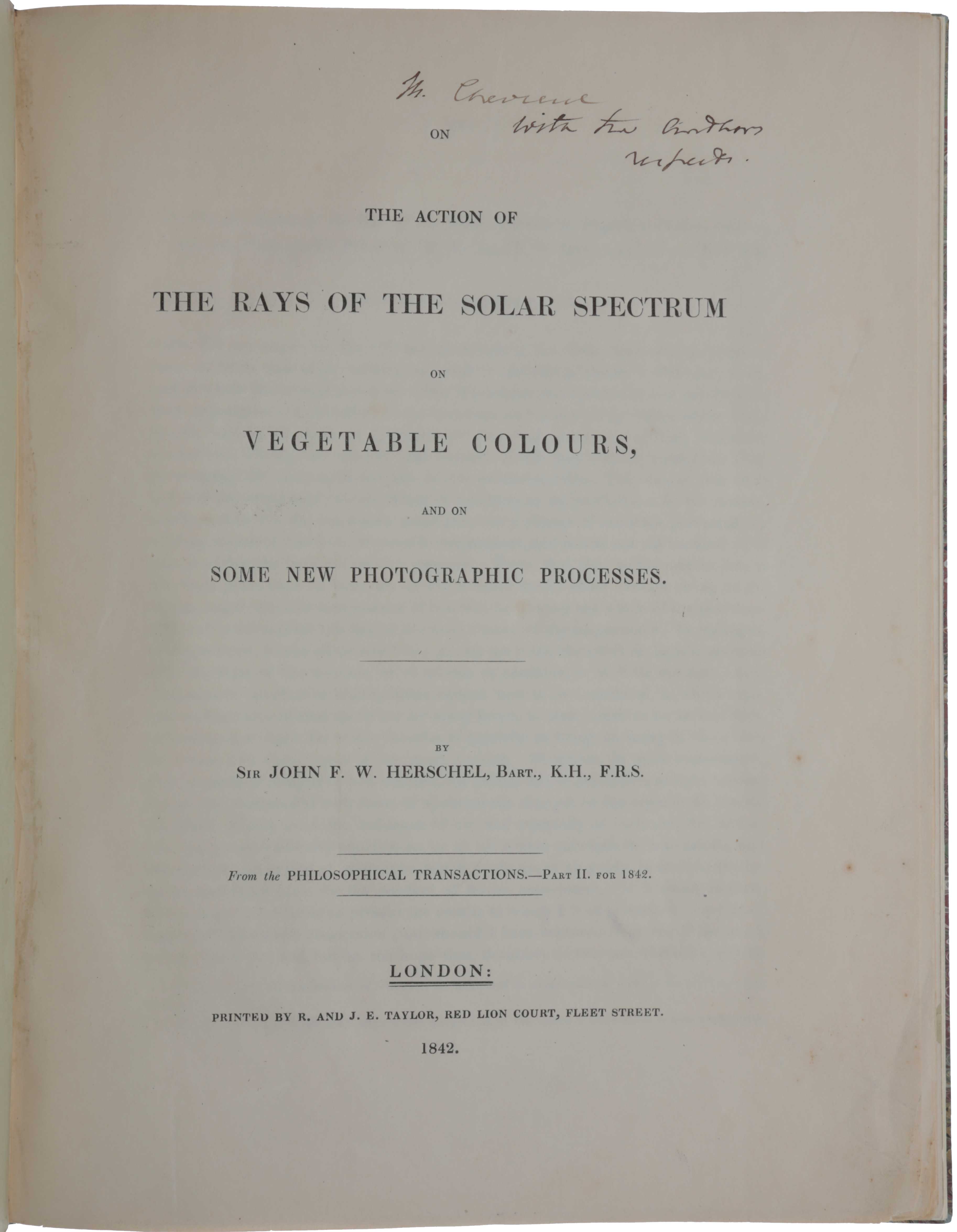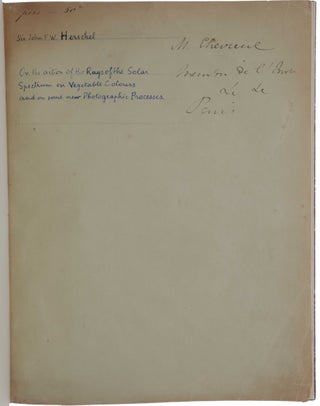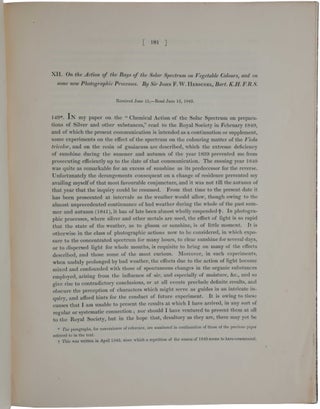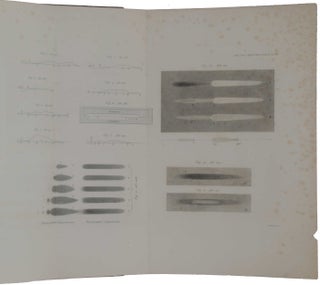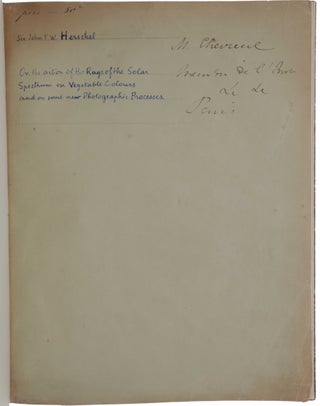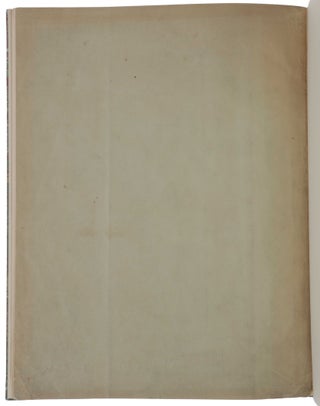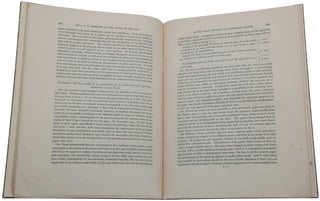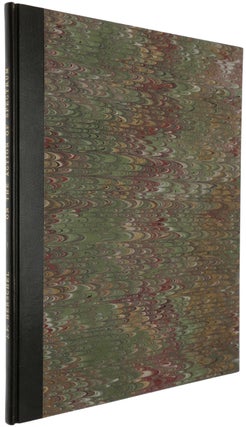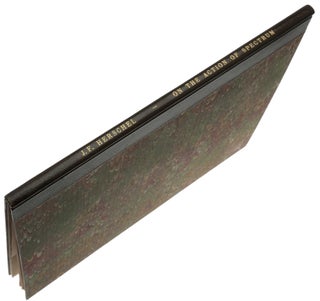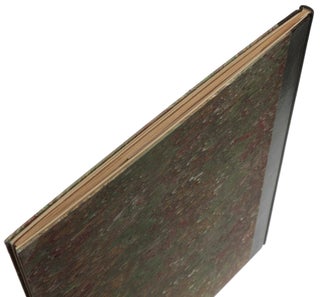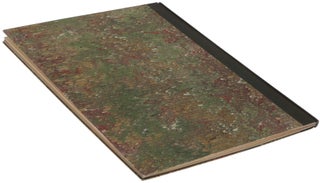On the action of the rays of the solar spectrum on vegetable colours, and on some new photographic processes.
London: R. & J. E. Taylor, 1842. First edition, extremely rare offprint, of this seminal early work of photography, the invention of the world’s first photocopying process, ‘cyanotype,’ later called ‘blue-printing’; this remained by far the most important reprographic process for more than a century after the publication of Herschel’s paper. This is an extraordinary presentation copy, inscribed by Herschel to the great French colour theorist Michel-Eugène Chevreul. “Photography in Prussian blue was discovered in 1842 by Sir John Herschel just three years after Louis Daguerre and Henry Talbot had announced their independent inventions of photography in silver, using metal and paper substrates, respectively. Their successes in finally securing silver photographs represented the fruition of an idea that had been gestating for more than a century in the minds and laboratories of many noted natural philosophers. In contrast, the birth of cyanotype came, literally and metaphorically, ‘out of the blue’, to a single parent … As one of the leading physical scientists of his day, Herschel was driven by the urge to understand photochemical phenomena, and to harness them as tools for probing the electromagnetic spectrum beyond the narrow optical limits imposed by human vision. Using light-sensitive coatings on paper, he sought to venture below the shortwave end of the visible spectrum, into the region of the ultra-violet or ‘actinic’ rays discovered in 1801 by Johann Ritter; and above the longwave visible limit, into the region of the infra-red or ‘thermic’ rays, which had been discovered in 1800 by his father, Sir William Herschel … There is no compelling evidence to suggest that he was in pursuit of commercially useful methods of reprography, unlike Talbot, whose clear aim was to multiply his photographic images in printer’s ink. It is therefore a happy irony that Herschel should have been responsible for inventing the first process for photocopying” (Ware, Cyanotype: the history, science and art of photographic printing in Prussian blue (1999), p. 11). “Only in 1872, one year after Herschel died, was the cyanotype revived, when the Paris-based Marion and Company renamed his invention ‘ferro-prussiate paper’ and began marketing it for the replication of architectural plans. (Previously, they had been copied by hand, which was expensive and prone to human error.) At the 1876 Philadelphia Centennial Exposition, the process reached American shores, where it finally met success as the blueprint, the first inexpensive means of duplicating documents. All that was required was a drawing traced on translucent paper. Pressed against a second sheet coated with Herschel’s chemical under glass, the drawing was exposed to sunlight, then washed in water. The blueprint paper recorded the drawing in reverse, black lines appearing white against a cyan background” (Keats, ‘The Blueprint,’ Scientific American 301 (2009), p. 90. ABPC/RBH list only a copy offered by Goldschmidt in 1936 (not a presentation copy). We have located only one other copy in commerce, offered by Ernst Weil in his Catalogue 7 (ca. 1946). Provenance: Michel-Eugène Chevreul (inscribed by Herschel on title ‘M. Chevreul with the authors respects’ and on original front wrapper ‘M. Chevreul Membre de l’Inst[itut] &c &c. Paris’). “As a scientist Sir John Herschel was naturally more interested in the theory of photography than in its practice. Photography is indebted to him for a wealth of ideas, but those who developed them often neglected to acknowledge their originator. Herschel was of a retiring disposition and never pushed forward his claims; indeed, we marvel at the restraint with which he bore the incorrect behaviour of Talbot who, thwarted in his desire for public acclaim, hastened to the Patent Office with more than one idea which Herschel had freely published. “Herschel’s photographic researches are concentrated within the first few years after the discovery of photography, and the genius and energy which he displayed were overwhelming. For him, it would have been an easy matter to invent a photographic process earlier had he felt, like Niépce, any urge to do so, or had he believed that it would facilitate his work, as Daguerre and Talbot and Reade did. As far back as 1819 Herschel discovered the property of the hyposulphites as solvents for silver salts, whereas ignorance of this fact had proved the stumbling-block to other investigators in photography for a long time. Herschel’s scientific knowledge was indeed so great that on merely receiving a note, on 22 January 1839, from Captain (later Admiral) Beaufort telling him the bare fact of Daguerre’s discovery, ‘a variety of processes at once presented themselves,’ and only a week later Herschel succeeded in producing his first photograph” (Gernsheim & Gernshein, The History of Photography1685-1914 (1969), p. 95). Herschel learned of Talbot’s competing process just a few days after Daguerre’s. “In January of 1839, stimulated by Talbot's announcement of his invention of photogenic drawing, Herschel took up the study of photographic phenomena. Within a week he had solved the problem of silver fixation. In contrast to Talbot's single-minded pursuit of the silver image, however, Herschel soon began to widen his investigations in the search for other viable photographic systems … To the enduring benefit of the embryonic science of photography, the spring of 1840 was remarkably brilliant. Herschel had already initiated a new series of exposure tests of 'vegetable colours' using extracts of the juices of plants and flowers, but this work was interrupted in March by the removal of the family home from Slough in Buckinghamshire to Hawkhurst in Kent. Once resettled, Herschel resumed his experiments in August, but by then he frequently found the sun to be 'pale' or 'desultory', requiring long exposures for these very insensitive processes. He pursued them nonetheless, during the very poor summer of 1841 that followed … In the early spring of 1842, Herschel suspended his tests of plant colours in favour of further broadening his search for new photosensitive substances; his attention transferred from these rather evanescent organic dyes (now appropriately called anthocyanins) to deeply-coloured inorganic compounds” (Ware, p. 23). “Early in 1842, the electro-chemist Alfred Smee sent Herschel a quantity of the bright red compound called potassium ferricyanide. While testing the sensitivity of this substance under the light of the spectrum, Herschel noted that it acted with much the same sensitivity as guaiacum, and when thrown into water, it became a deep Prussian blue. Smee suggested two further compounds, Ammonio Citrate and Ammonio Tartrate of Iron, and by June of 1842, Herschel had developed both the Chrysotype, named for its use of gold ‘to bring about the dormant picture,’ and the Cyanotype, his most practical and enduring process” (Hannavy, Encyclopedia of Nineteenth-Century Photography, p. 655). “The 15th of June 1842 was the day on which Herschel's long and important paper, entitled 'On the Action of the Rays of the Solar Spectrum on Vegetable Colours, and on some new Photographic Processes' was accepted for publication in the Philosophical Transactions of the Royal Society. Part of this paper was read before the Society on 16 June, but it was not to appear in print until September. It will be convenient to refer to this seminal work as ‘the 1842 Paper’. It was here that Herschel first publicly described the making of prints in Prussian blue from potassium ferricyanide alone, as follows: ‘202. A beautiful example of such deoxidising action on a non-argentine compound has lately occurred to me in the examination of that interesting salt, the ferrosesquicyanuret of potassium, described by Mr. Smee in the Philosophical Magazine, No.109, September 1840, and which he has shown how to manufacture in abundance and purity by voltaic action on the common, or yellow ferrocyanuret. “It is clear from the 1842 Paper that, by June, Herschel had also made cyanotypes (but not yet named them thus) by exposing a mixture of ammonium ferric citrate and potassium ferricyanide – the recipe that has endured as the standard practice until the present day: ‘206. If in lieu of the perchloride of iron, we substitute a solution of that curious salt the ammonio-citrate of iron, the photographic effects are among the most various and remarkable that have yet offered themselves to our notice in this novel and fertile field of inquiry. The two solutions mix without causing any precipitate, and produce a liquid of a brown colour, which washed over paper is green (being strongly dichromatic). If this be done under the prism, the action of the spectrum is almost instantaneous, and most intense. A copious and richly coloured deposit of Prussian blue is formed over the blue, violet and extra-spectral rays’ … “Prussian blue printing was totally eclipsed during the intervening month of July by Herschel's endeavours - again employing the marvellously versatile ammonium ferric citrate - to make pictures in mercury and gold, whose striking beauty captivated his undivided attention … The following week in August, however, saw Herschel's return to printing in Prussian blue, with fresh endeavours to refine and perfect the processes. His chemical logic suggested that a complementary, positive-working system could be achieved by employing, not the ferricyanide, but the commonplace ferrocyanide of potassium, in conjunction with ammonium ferric citrate … By the end of August he had accumulated sufficient new results to justify adding a substantial postscript to his 1842 Paper, which was still awaiting publication by the Royal Society. It is in this postscript, dated 29 August 1842, that the name 'cyanotype' appears in print for the first time” (Ware, ‘John Herschel’s Cyanotype: invention or discovery?’). “Herschel’s experiments on photographic subjects came to a halt in 1843, victims of his astronomical writing and public duties. But his interest in photography never ceased. Anna Atkins, a close friend of the Herschel family, immediately took up the cyanotype in her self-publishing effort in Botany. Julia Margaret Cameron declared that Sir John was ‘her first teacher’ and immortalized him in a series of portraits. In 1845 Herschel published his final contribution to photographic research, an observation of what he called ‘epipolic dispersion’ (nos. 46 & 47). George Gabriel Stokes would later rename this phenomenon ‘fluorescence’, the study of which led directly to radiation photography of all types” (Hannavy, p. 655). “At first, Herschel’s invention was only taken up by a small elite of amateur botanists for the purposes of plant illustration. The most notable achievement was that of Anna Atkins who, during two decades from 1843, produced her now famous and highly-treasured album of botanical photographs [Photographs of British Algae: cyanotype impressions]. But in the Great Exhibition of 1851, the cyanotype process was represented by just one minor specimen, among a multitude of exhibits illustrating the burgeoning art-science of photography. This must be taken as a sign of the insignificant status accorded to cyanotype at the time. It continued in disuse for a further 20 years. Following Herschel’s death in 1872, the ‘re-invention’ of cyanotype by entrepreneurs of a more commercial turn of mind than the inventor, exploited its potential as a reprographic medium for the first time. The re-styles ‘ferroprussiate’ process also found some use among photographers as a cheap and easy option for proofing negatives, but its major market was for copying the plans in every drawing office … “In Britain, the cyanotype has suffered an almost total aesthetic boycott by photographic artists, connoisseurs, and curators until the last decade or two. By contrast, one can point to huge archives of cyanotypes where the utility of the process was the paramount consideration. The commercial success of the cyanotype process was owed, not to its pictorial use, but its reprographic applications. These have endowed our language with a new word: ‘blueprint,’ a word that has now taken on an expanded and more abstract meaning which endures long after the process it described became obsolete. The era of the blueprint as a copying process was heralded by the manufacture of cheap, sensitized paper in huge quantities. By the turn of the century its use for copying engineering and architectural plans had become universal in drawing offices. In 1918, a 30-foot roll of cyanotype paper a yard wide could be purchased for as little as 1s. 6d. This was just as well, because consumption must have been enormous: the plans for a battleship, for instance, consumed 11,000 square feet of the material. Although it faced two or three competing processes, the blueprint held sway for 80 years as the foremost industrial reproduction process, and was only finally displaced in the mid-1950s in the UK, first by the diazo print medium, and then by the invention of electrophotography, which enabled photocopying by entirely dry methods. It is interesting to note that commercial production and use of blueprint paper, though dwindling, was still significant in 1972 in the USA, and production of the paper persists there still, albeit on a very reduced scale” (Ware, pp. 12-14). John Frederick William Herschel (1792-1871) was born at Observatory House in Slough, where his father, the Astronomer Royal Sir William Herschel, discovered the planet Uranus. “As a result, Observatory House was a scientific landmark and it was visited throughout John Herschel’s childhood by royalty, gentry and scientists from all parts of the world. Growing up in such a household and under the influence of his renowned father and aunt, the astronomer Caroline Lucretia Herschel, it is hardly surprising that John Herschel acquired his own fame in astronomical and mathematical subjects. But, as he wrote to his wife Margaret in 1841, ‘Light was my first love.’ And it was through this lifelong interest in the properties and vagaries of light that he came to photography” (Hannavy, p. 653). “Herschel played important roles in major scientific organizations—including the Royal Society, the Astronomical Society (later the Royal Astronomical Society), and the British Association for the Advancement of Science—became a member of dozens of others throughout Europe, and served as an advisor to numerous national committees and large-scale, data-gathering projects, such as the mapping of Earth’s magnetic field and the collecting of meteorological data” (DSB). Michel-Eugène Chevreul (1786-1889) spent the first two decades of his working life as an organic chemist. In 1824, “soon after his appointment that year as director of dyeing at the tapestry works in Gobelin, he received complaints about the lack of vigour in tapestry colours. He found that the problem was not chemical in nature but optical. His lengthy investigation into the optical mixing of colours led to his finding several types of contrast of colour and tone and a formulation of the law of simultaneous contrast: colours mutually influence one another when juxtaposed, each imposing its own complementary colour on the other. The fruit of his colour studies was De la loi du contraste simultané des couleurs (1839), his most influential book. He provided many examples of how juxtaposed colours can enhance or diminish each other’s intensity, and he described many ways to produce desired colour effects, such as with massed monochromatic dots. To represent colours by definite standards, he brought together all of the colours of the visible spectrum, relating them to each other in a circular system, and he also produced scales of thousands of tints. He applied his findings to Gobelin tapestries and textiles, wallpaper, horticulture, mapmaking, colour printing, mosaics, and painting. Indeed, he ‘wrote the book’ for artists, designers, and decorators. His book, with its English and German translations, became the most widely used colour manual of the 19th century” (Britannica). Boni, Photographic Literature, p. 91; Poggendorff I, 1090.
203. Paper simply washed with a solution of this salt is highly sensitive to the action of light. Prussian blue is deposited. After half an hour or an hour's exposure to sunshine, a very beautiful negative photograph is the result' …
Offprint from: Philosophical Transactions of the Royal Society of London, Vol. 132, Part II. 4to (298 x 229 mm), pp. [ii], [181]-214, with one folding engraved plate. Half-morocco gilt by Honnelaitre, with the mute original paper wrappers bound in. A fine copy.
Item #4782
Price: $28,500.00

